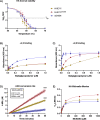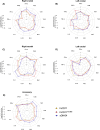Amino acid 138 in the HA of a H3N2 subtype influenza A virus increases affinity for the lower respiratory tract and alveolar macrophages in pigs
- PMID: 38377132
- PMCID: PMC10906893
- DOI: 10.1371/journal.ppat.1012026
Amino acid 138 in the HA of a H3N2 subtype influenza A virus increases affinity for the lower respiratory tract and alveolar macrophages in pigs
Abstract
Influenza A virus (FLUAV) infects a wide range of hosts and human-to-swine spillover events are frequently reported. However, only a few of these human viruses have become established in pigs and the host barriers and molecular mechanisms driving adaptation to the swine host remain poorly understood. We previously found that infection of pigs with a 2:6 reassortant virus (hVIC/11) containing the hemagglutinin (HA) and neuraminidase (NA) gene segments from the human strain A/Victoria/361/2011 (H3N2) and internal gene segments of an endemic swine strain (sOH/04) resulted in a fixed amino acid substitution in the HA (A138S, mature H3 HA numbering). In silico analysis revealed that S138 became predominant among swine H3N2 virus sequences deposited in public databases, while 138A predominates in human isolates. To understand the role of the HA A138S substitution in the adaptation of a human-origin FLUAV HA to swine, we infected pigs with the hVIC/11A138S mutant and analyzed pathogenesis and transmission compared to hVIC/11 and sOH/04. Our results showed that the hVIC/11A138S virus had an intermediary pathogenesis between hVIC/11 and sOH/04. The hVIC/11A138S infected the upper respiratory tract, right caudal, and both cranial lobes while hVIC/11 was only detected in nose and trachea samples. Viruses induced a distinct expression pattern of various pro-inflammatory cytokines such as IL-8, TNF-α, and IFN-β. Flow cytometric analysis of lung samples revealed a significant reduction of porcine alveolar macrophages (PAMs) in hVIC/11A138S-infected pigs compared to hVIC/11 while a MHCIIlowCD163neg population was increased. The hVIC/11A138S showed a higher affinity for PAMs than hVIC/11, noted as an increase of infected PAMs in bronchoalveolar lavage fluid (BALF), and showed no differences in the percentage of HA-positive PAMs compared to sOH/04. This increased infection of PAMs led to an increase of granulocyte-monocyte colony-stimulating factor (GM-CSF) stimulation but a reduced expression of peroxisome proliferator-activated receptor gamma (PPARγ) in the sOH/04-infected group. Analysis using the PAM cell line 3D4/21 revealed that the A138S substitution improved replication and apoptosis induction in this cell type compared to hVIC/11 but at lower levels than sOH/04. Overall, our study indicates that adaptation of human viruses to the swine host involves an increased affinity for the lower respiratory tract and alveolar macrophages.
Copyright: This is an open access article, free of all copyright, and may be freely reproduced, distributed, transmitted, modified, built upon, or otherwise used by anyone for any lawful purpose. The work is made available under the Creative Commons CC0 public domain dedication.
Conflict of interest statement
The authors have declared that no competing interests exist.
Figures








Similar articles
-
2018-2019 human seasonal H3N2 influenza A virus spillovers into swine with demonstrated virus transmission in pigs were not sustained in the pig population.J Virol. 2024 Dec 17;98(12):e0008724. doi: 10.1128/jvi.00087-24. Epub 2024 Nov 11. J Virol. 2024. PMID: 39526773 Free PMC article.
-
A novel reassorted swine H3N2 influenza virus demonstrates an undetected human-to-swine spillover in Latin America and highlights zoonotic risks.Virology. 2025 May;606:110483. doi: 10.1016/j.virol.2025.110483. Epub 2025 Mar 5. Virology. 2025. PMID: 40073501
-
Quantifying the impact of vaccination on transmission and diversity of influenza A variants in pigs.J Virol. 2024 Dec 17;98(12):e0124524. doi: 10.1128/jvi.01245-24. Epub 2024 Nov 12. J Virol. 2024. PMID: 39530665 Free PMC article.
-
Systemic pharmacological treatments for chronic plaque psoriasis: a network meta-analysis.Cochrane Database Syst Rev. 2021 Apr 19;4(4):CD011535. doi: 10.1002/14651858.CD011535.pub4. Cochrane Database Syst Rev. 2021. Update in: Cochrane Database Syst Rev. 2022 May 23;5:CD011535. doi: 10.1002/14651858.CD011535.pub5. PMID: 33871055 Free PMC article. Updated.
-
Surgical interventions for treating intracapsular hip fractures in older adults: a network meta-analysis.Cochrane Database Syst Rev. 2022 Feb 14;2(2):CD013404. doi: 10.1002/14651858.CD013404.pub2. Cochrane Database Syst Rev. 2022. PMID: 35156192 Free PMC article.
Cited by
-
Passage of human-origin influenza A virus in swine tracheal epithelial cells selects for adaptive mutations in the hemagglutinin gene.PLoS One. 2025 Aug 13;20(8):e0327096. doi: 10.1371/journal.pone.0327096. eCollection 2025. PLoS One. 2025. PMID: 40802672 Free PMC article.
-
Air-liquid interface model for influenza aerosol exposure in vitro.J Virol. 2025 Jul 22;99(7):e0061925. doi: 10.1128/jvi.00619-25. Epub 2025 Jun 3. J Virol. 2025. PMID: 40459258 Free PMC article.
-
Impact of swine influenza A virus on porcine reproductive and respiratory syndrome virus infection in alveolar macrophages.Front Vet Sci. 2024 Aug 26;11:1454762. doi: 10.3389/fvets.2024.1454762. eCollection 2024. Front Vet Sci. 2024. PMID: 39253525 Free PMC article.
-
Genomic surveillance of influenza A virus in live bird markets during the COVID-19 pandemic.Vet World. 2025 Apr;18(4):955-968. doi: 10.14202/vetworld.2025.955-968. Epub 2025 Apr 23. Vet World. 2025. PMID: 40453955 Free PMC article.
-
Modulation of human-to-swine influenza a virus adaptation by the neuraminidase low-affinity calcium-binding pocket.Commun Biol. 2024 Oct 1;7(1):1230. doi: 10.1038/s42003-024-06928-6. Commun Biol. 2024. PMID: 39354058 Free PMC article.
References
-
- Nelson MI, Wentworth DE, Culhane MR, Vincent AL, Viboud C, LaPointe MP, et al.. Introductions and evolution of human-origin seasonal influenza a viruses in multinational swine populations. J Virol. 2014;88(17):10110–9. Epub 20140625. doi: 10.1128/JVI.01080-14 ; PubMed Central PMCID: PMC4136342. - DOI - PMC - PubMed
MeSH terms
Substances
Grants and funding
LinkOut - more resources
Full Text Sources
Miscellaneous

